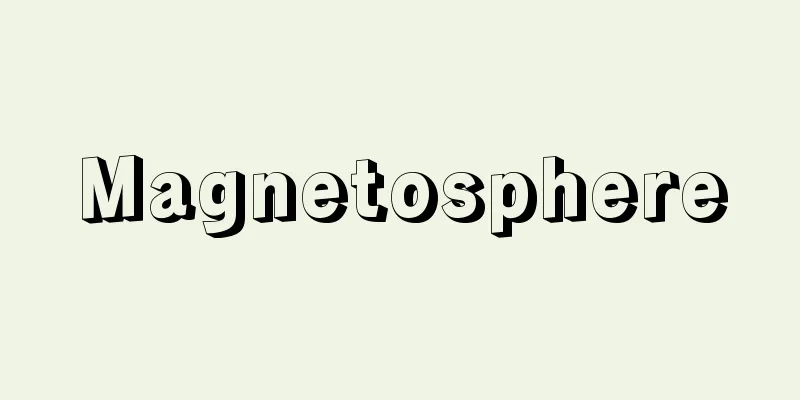Magnetosphere

|
The Earth's magnetic field is confined to a finite area by the solar wind, which constantly blows out from the Sun into interplanetary space. The space controlled by this Earth's magnetic field is called the Earth's magnetosphere. Magnetospheres exist not only around Earth, but also around planets with magnetic fields such as Mercury, Jupiter, Saturn, Uranus, and Neptune. Direct exploration by Pioneer and Voyager revealed that Jupiter and Saturn, which have strong magnetic fields, are surrounded by huge magnetospheres. [Kokubun Seiji] Shape of the Earth's magnetosphereThe shape of the Earth's magnetosphere is determined by the balance between the dynamic pressure of the solar wind and the pressure of the magnetospheric magnetic field. The shape of the part facing the solar wind is close to an ellipsoid. The magnetopause is about 10 Re (Re is the radius of the Earth, 6,370 km) from the center of the Earth at its tip near noon, and about 15 Re on the morning and evening sides. The night side is stretched by the solar wind like the tail of a comet. The area up to about 240 Re from the center of the Earth is directly observed by scientific satellites. From 1992 to 1994, precise observations were made by the Japanese magnetosphere exploration satellite GEOTAIL, and it was confirmed that the tail always exists up to about 220 Re. The diameter of the tail gradually expands up to about 120 Re, and is about 60 Re further away. Detailed observations of more distant regions have not yet been made, but it is thought to extend like a streamer to distances of 2,000 to 3,000 Re. The magnetosphere is an area that solar wind plasma cannot directly penetrate, so it is an obstacle from the solar wind's perspective. Since the solar wind flows at supersonic speed, a standing shock wave is created in front of the magnetosphere, and it is attached in a shape close to a hyperboloid, just as a shock wave is generated in front of an object moving through gas at supersonic speed. The area between this shock wave and the magnetopause is called the magnetosheath, where a turbulent magnetic field is observed. The solar wind plasma that passes through the shock wave is compressed at the front of the magnetosphere, its temperature increases, and it passes the side of the magnetosphere and flows away, increasing its speed again. An electric current flows at the magnetopause, which is determined by the equilibrium condition between the dynamic pressure of the solar wind and magnetic pressure. This current flows eastward on the dayside, strengthening the magnetic field on the ground; if the dynamic pressure of the solar wind increases, the magnetosphere is further compressed, and the magnetic field on the ground is strengthened. On the boundary between the northern and southern hemispheres of the tail, the electric current flows from the evening side to the morning side, flows into the magnetosphere near the equator, and closes the equatorial region from the morning side to the evening side, forming a figure-8 shape ( ). The magnetopause, which is the boundary between the solar wind and magnetospheric plasma, is not a simple surface, but has a layered structure that shows different properties depending on the location. Electromagnetic disturbances and plasma waves occur at the magnetopause, like ripples on the surface of water when the wind blows, and a boundary layer is formed where the solar wind and magnetospheric plasma flow together. The region between 9:00 and 15:00 around noon on the day side, connected by magnetic field lines passing through the vicinity of geomagnetic latitude 76-80 degrees, is called the cusp. The center of this cusp region is the boundary between the magnetic field lines that open toward the tail on the night side and the magnetic field lines that close on the low-latitude side. In the cusp region, the magnetic field is small, and magnetosheath plasma directly penetrates the magnetosphere and descends along the magnetic field lines into the ionosphere. The boundary layer structure is different on the low-latitude side and high-latitude side of the cusp, and is called the low-latitude boundary layer and the plasma mantle, respectively. In the plasma mantle, which has a thickness of 0.4 to 4 Re, part of the plasma that has entered from the cusp region flows along the magnetic field lines toward the tail at a speed of 100 to 200 kilometers per second. [Kokubun Seiji] Plasma Region DivisionThe plasma inside the magnetosphere is mainly protons and electrons, but also contains atomic oxygen ions and helium ions. The temperature and velocity distribution of the magnetospheric plasma vary significantly depending on location, and these characteristics allow the magnetosphere to be divided into several regions. (1) Plasmasphere The region from about 4 Re in the morning to about 6 Re in the afternoon is filled with relatively low-temperature plasma flowing out from the ionosphere, and is distinguished from other regions as the plasmasphere. At the boundary of the plasmasphere, called the plasmapause, the density changes suddenly, and a decrease of more than one order of magnitude from 100-1000 particles per cubic centimeter to 1-10 particles per cubic centimeter is observed in a narrow region of about 0.1 Re. The low-energy plasma in the plasmasphere rotates with the Earth's rotation. On the other hand, in the region outside the plasmapause, large-scale convection is generated by the electric field and momentum supplied by the solar wind. When the plasma in the outer magnetosphere is carried by this convection to the night side, it moves to the magnetic field lines that open toward the tail and is efficiently lost, so its density becomes lower than that inside the plasmasphere. The position of the plasmapause is determined by the balance between this convection motion and co-rotation, so if the convection becomes stronger due to changes in the solar wind or interplanetary magnetic field, the plasmapause moves toward the Earth. (2) Radiation belt: A group of charged particles ranging from tens of keV (kilo electron volts) to several MeV (million electron volts) are captured by the Earth's magnetic field in a region extending from an altitude of about 1,000 km to a geocentric distance of 6 to 7 Re, and surround the Earth in a belt-like shape. In the inner belt at a geocentric distance of 1.2 to 2 Re, high-energy particles of several MeV or more are stably captured. Particles below MeV are distributed around 3 to 5 Re (outer belt), and are more variable than the inner belt. The existence of these radiation belts was revealed by the Van Allen group through early satellite observations, so they are also called the Van Allen belts. The existence of radiation belts around the Earth that are more than 100 million times the natural radiation intensity on the Earth's surface was not predicted until direct observation in 1958. A group of high-energy particles existed in an area that charged particles coming from outside the Earth could not directly penetrate. This discovery is known as an important scientific discovery in the early days of satellite observations. The particles that make up the radiation belt are captured by the Earth's magnetic field and move back and forth from north to south along the magnetic field lines as they orbit the Earth. Protons orbit westward, and electrons orbit eastward. The speed of the orbit is roughly proportional to the energy, and one orbit takes a few minutes to a few hours. As a result of this motion, the radiation belt particles form a westward current system (equatorial ring current) that encircles the Earth in a ring. The magnetic field caused by the equatorial ring current observed on the ground is proportional to the total energy of the trapped particles. The lifetime of radiation belt particles is mainly regulated by the Earth's atmosphere, and experimentally, the lifetime of a 2MeV electron is about one year near the inner belt and about one month near the outer belt. Most of the radiation belt particles are particles originating from the solar wind that flow into the magnetosphere and gradually gain energy as they are carried inward. However, the sudden change in the onset of a large geomagnetic storm in March 1991 (the first signal indicating the arrival of a plasma cloud released by a solar surface explosion such as a solar flare) was observed to have created a new radiation belt, raising new questions about the acceleration mechanism of radiation belt particles. It is believed that the high-energy particles that make up the inner belt are formed when some of the neutrons produced by collisions between cosmic rays and atmospheric molecules undergo beta decay into protons, electrons, and neutrinos on their way to the magnetosphere, and are then captured by the magnetic field. (3) Magnetotail The magnetotail, which stretches out in a long, narrow direction opposite to the sun on the night side of the Earth, is divided into two characteristic regions: the plasma sheet and the lobe. In the tail, the magnetic field lines connecting to the northern hemisphere and the southern hemisphere are almost antiparallel (same magnitude but opposite direction), so the magnetic field strength is very small near the tail equator. This area near the equator is also called the magnetic neutral surface because the magnetic field is close to zero. For such antiparallel magnetic fields to exist stably, plasma must exist around the magnetic neutral surface to support the magnetic pressure caused by the antiparallel magnetic field. In fact, near the magnetic neutral surface, there exists high-temperature plasma with a density of 0.1 to 1 particle per cubic centimeter, and this area is called the plasma sheet. The average energies of protons and electrons in this area are about 5 keV and 1 keV, respectively. The thickness of the plasma sheet is about 4 Re from the neutral surface in the north-south direction on average, and it becomes thicker toward the morning and evening sides. The Earth-side boundary of the plasma sheet is at a distance of 8 to 10 Re, and corresponds to the equatorial side of the aurora appearance zone. The average flow in the plasma sheet changes from toward the Earth to away from the Earth at approximately 120 Re from the Earth. The space on the high-latitude side of the plasma sheet up to the magnetopause is called the lobe. This region is characterized by an extremely low plasma density, approximately 0.05 particles per cubic centimeter. While the plasma sheet is the source of auroral particles, the lobe is connected to the polar cap region on the high-latitude side of the aurora appearance zone. [Kokubun Seiji] Magnetosphere and Interplanetary Magnetic FieldThe magnetosphere is constantly changing in response to changes in the solar wind. The sudden changes that signal the start of a geomagnetic storm are caused by the sudden compression of the magnetosphere due to the passage of a shock wave associated with a high-speed plasma cloud released by an explosion on the surface of the Sun, and the intensification of magnetopause currents. When the magnetosphere is enveloped in a high-speed plasma cloud, the magnetosphere can be compressed to the extent that a geostationary satellite (located 6.6 Re away) is forced out of the magnetosphere. However, even if the magnetosphere is strongly compressed by a high-speed, high-density plasma cloud, a geomagnetic storm will not develop if the magnetic field in the plasma cloud does not have a southerly component. In other words, the change in the direction of the magnetic field carried by the solar wind controls the inflow of solar wind energy that causes fluctuations in the magnetosphere. (1) Magnetic reconnection The Earth's magnetic field is almost always oriented in a constant direction relative to the solar wind, but the magnetic field carried by the solar wind is constantly fluctuating, so the component in the opposite direction to the Earth's magnetic field, that is, in the south, can become large. When a magnetic field with an opposite component collides with the magnetosphere, a reconnection (reconnection) occurs between the interplanetary magnetic field and the Earth's magnetic field. When the interplanetary magnetic field is oriented southward, the Earth's magnetic field connects with the interplanetary magnetic field on the day side of the magnetosphere, and the reconnected magnetic field is peeled off from the day side and moves toward the night side with the solar wind. Since magnetospheric plasma moves with the magnetic field, a plasma flow from the lobe toward the plasma sheet occurs in the night side magnetosphere as the magnetic field lines move. As in the front of the magnetosphere, magnetic fields of different directions are carried in near the equator in the tail, magnetic field reconnection occurs in the center of the plasma sheet, and flows toward the Earth and toward the opposite direction to the Earth are created. The flow returning toward the Earth wraps around the day side, forming a large closed circulation overall, and magnetospheric convection occurs. The plasma that is generated by reconnection and blows out in the direction opposite to the Earth returns to the solar wind. When the interplanetary magnetic field is pointing northward, reconnection also occurs at the boundary region of the lobe, but large-scale convection does not occur. Observations have confirmed that the plasma flow reverses in the magnetotail, at a distance of about 120 Re from the center of the earth, indicating that reconnection in the tail plasma sheet occurs on average at about 120 Re ( ). (2) Magnetospheric storms Large-scale fluctuations that affect the entire magnetosphere, such as auroras, are called magnetospheric substorms. The energy required to cause a magnetospheric storm is only about 10% of the energy of the solar wind that strikes the magnetosphere. The efficiency of the energy inflow from the solar wind is thought to be determined by the reconnection of the magnetic field. The ground state of the magnetosphere, in which aurorae and geomagnetic activity are at their quietest, corresponds to the state when the north-south component of the interplanetary magnetic field is positive for more than a few hours. When the interplanetary magnetic field is northward, almost no fluctuations are observed except in some parts of the polar cap region. For example, the aurorae appearance zone, which is on average around geomagnetic latitude 67 degrees, moves to higher latitudes, and bright active auroras are no longer observed. When the interplanetary magnetic field turns southward on a time scale of approximately one hour or more, reconnection progresses on the dayside magnetopause, and the magnetosphere as a whole changes. The magnetic field lines are peeled off from the dayside magnetosphere, and the magnetosphere front moves inward by about 1 Re. The peeled off magnetic field lines are carried to the tail, and the diameter of the tail and the strength of the lobe magnetic field increase. A large-scale plasma flow is excited in the outer magnetosphere with a time lag of 10 to 20 minutes. Due to new changes in the tail, the increase in the lobe magnetic field and the convection electric field, plasma is carried from the outside, and the plasma sheet current becomes stronger. The near-tail plasma sheet condenses into a thin layer. This state continues for several tens of minutes (growth phase), and in the polar regions, arc-shaped auroras gradually become brighter and move toward the equator, and the ionospheric current system consisting of two vortices corresponding to the development of magnetospheric convection is strengthened. Near the geostationary orbit near the Earth-side boundary of the plasma sheet, the magnetic field is stretched from a dipole type to a tail type. When the plasma sheet current has developed to a certain extent, the thin plasma sheet layer, which has been compressed to several hundred kilometers (less than one-tenth of its thickness during quiescence), suddenly collapses on a time scale of about one minute, the current decreases, and the magnetic field lines in the tail, which had been stretched, move toward the Earth near the equator and outward at high latitudes, returning to a dipole-shaped magnetic field. In the near-tail region (region 22-30 Re away from the center of the earth), violent fluctuations occur accompanied by reconnection. Correspondingly, active auroral activity and violent magnetic field fluctuations are observed in the polar regions (expansion phase). Magnetospheric storms are phenomena that occur on a time scale of one to three hours. [Kokubun Seiji] "Aurora: Electrical Discharge Phenomenon Surrounding the Earth" by Shunichi Akasofu (1975, Chuokoron-Shinsha)" ▽ "The Mysterious Light of the Aurora" by Takashi Oguchi (1978, NHK Publishing)" ▽ "Physics of the Solar and Planetary Environment" by Tan Maeda (1982, Kyoritsu Shuppan)" ▽ "A Planet of Life Protected by Multiple Barriers: Atmosphere and Magnetosphere" by NHK Reporting Team (1987, NHK Publishing)" ▽ "Symphony from Space: Ultra-High Plasma Waves" by Masashi Hayakawa (1993, Corona Publishing)" ▽ "The Universe, Earth, Life, and the Brain: In Search of Their Principles" by Takashi Tachibana (1999, Asahi Shimbun)" ▽ "Invitation to Outer Space" by Atsuhiro Nishida (Iwanami Shinsho)" ▽ "The Aurora: Its Mystery and Fascination" by Shunichi Akasofu (Iwanami Shinsho) [References] | | | | | | | | | |geomagnetic field| | | | | |The magnetosphere is divided into characteristic regions, such as the magnetopause, plasmasphere, and radiation belt. There are also several current systems associated with interactions with the solar wind and auroral phenomena. The equatorial ring current (composed of trapped particles such as the high-energy particles that make up the radiation belt), part of the magnetic neutral surface flows into the ionosphere along magnetic field lines due to the development of magnetospheric storms, and field-aligned current systems (related to the inflow of energy from the magnetosphere to the ionosphere) exist almost constantly. In the morning, it flows into the pole side of the aurora appearance zone, and at lower latitudes it flows out into the magnetosphere, and in the afternoon, it becomes a current in the opposite direction . Conceptual diagram of the Earth's magnetosphere (Figure A) The Earth's magnetic field, which connects with the solar wind magnetic field at the front of the magnetosphere, is carried in the night direction, along with the magnetic field in the solar wind, as shown in the figure, 2, 3, 4, etc. As a result, in the night-side magnetosphere, a flow is created from the lobe toward the plasma sheet. Near the equator in the tail, magnetic fields of different directions are carried in, and reconnection occurs. The reconnected magnetic field tries to contract due to magnetic tension, accelerating plasma toward and away from the Earth. When the magnetosphere is quiet, the reconnection region is located at a geocentric distance of around 120 Re, but during magnetospheric storms, reconnection also occurs in the near tail at 22-30 Re. ©Shogakukan "> Conceptual diagram of magnetic reconnection model (Figure B… Source: Shogakukan Encyclopedia Nipponica About Encyclopedia Nipponica Information | Legend |
|
太陽から絶えず惑星間空間に吹き出ている太陽風により、地球磁場はある有限な領域に閉じ込められている。この地球磁場に支配される空間を地球磁気圏という。磁気圏は、地球ばかりではなく、水星、木星、土星、天王星や海王星などの磁場をもつ惑星の周辺にも存在する。強い磁場をもつ木星や土星は巨大な磁気圏で囲まれていることが、パイオニアやボイジャーなどによる直接探査で明らかになった。 [國分 征] 地球磁気圏の形地球の磁気圏の形は、太陽風の動圧と磁気圏磁場の圧力との平衡でほぼ決まっている。太陽風に面した部分の形は回転楕円(だえん)体に近い。磁気圏境界面magnetopauseは、先端にあたる正午付近では、地球の中心から約10Re(Reは地球半径のこと。6370キロメートル)、朝側と夕方側では約15Reの距離にある。夜側は、太陽風によって彗星(すいせい)の尾のように引き伸ばされている。地心距離240Re付近までの領域は、科学衛星によって直接観測が行われている。1992~1994年(平成4~6)には、日本の磁気圏探査衛星GEOTAIL(ジオテール)により精密な観測が行われ、220Re付近まではつねに尾部が存在することが確かめられている。尾部の直径は120Re付近までは徐々に広がり、それより遠くでは約60Reである。さらに遠い領域の詳しい観測はまだなされていないが、2000~3000Reの距離まで吹流しのように伸びていると考えられている。 磁気圏は太陽風プラズマが直接侵入しえない領域なので、太陽風からみれば障害物となる。太陽風は超音速で流れているので、超音速で気体中を進む物体の前面に衝撃波が発生するように、磁気圏前面には定在衝撃波ができて、双曲面に近い形で張り付いている。この衝撃波と磁気圏境界面の間は、磁気シースmagnetosheathとよばれ、乱れた磁場が観測される。衝撃波を通過した太陽風プラズマは磁気圏前面で圧縮されて温度が上がり、磁気圏の側面を通過しふたたび速度を上げながら流れ去る。 磁気圏境界面には、太陽風の動圧と磁気圧の平衡条件で決まる電流が流れている。この電流は昼側では東向きに流れ、地上の磁場を強める効果を与え、太陽風の動圧が増加すれば磁気圏はさらに圧縮され、地上の磁場は強まる。尾部南北半球の境界面上では、電流は夕方側から朝側に流れ、赤道付近で磁気圏内に流れ込み、赤道域を朝側から夕方側の方向に貫き8の字状に閉じている()。 太陽風と磁気圏プラズマの境界をなす磁気圏境界面は、単なる面ではなく、場所によって異なる性質を示す層状構造になっている。磁気圏境界面には、風が吹いたとき水面に漣(さざなみ)が立つように電磁的な乱れやプラズマ波動が発生し、太陽風と磁気圏プラズマが交じり合って流れる境界層ができる。昼側正午を中心として9~15時の領域で、地磁気緯度76~80度付近を通る磁力線で結ばれている領域は、カスプcuspとよばれている。このカスプ領域の中心は、夜側の尾部に向かって開いた磁力線と低緯度側で閉じる磁力線の境界になっている。カスプ領域では、磁場が小さく、磁気シースプラズマが直接磁気圏内に侵入し、磁力線に沿って電離圏に降下する。カスプより低緯度側と高緯度側では境界層構造が異なり、それぞれ低緯度境界層、プラズママントルplasma mantleという。0.4~4Reの厚さをもつプラズママントルでは、カスプ領域から侵入したプラズマの一部が磁力線に沿って尾部の方向に、秒速100~200キロメートルの速さで流れている。 [國分 征] プラズマによる領域区分磁気圏内部のプラズマは、おもにプロトン(陽子)と電子であるが、酸素原子イオンやヘリウムイオンも存在する。磁気圏プラズマの温度や速度分布は場所により著しく変わるので、これらの特徴により磁気圏をいくつかの領域に分けることができる。 (1)プラズマ圏plasmasphere 地心距離が午前側で約4Re、午後側で約6Reまでの領域は、電離圏から流れ出た比較的温度の低いプラズマによって満たされており、プラズマ圏として他の領域と区別される。プラズマポーズplasmapauseとよばれるプラズマ圏の境界では、密度が急激に変わり、1立方センチメートル当り100~1000個から1~10個まで1桁(けた)以上の減少が0.1Re程度の狭い領域で観測される。プラズマ圏内の低エネルギープラズマは、地球の自転とともに回転している。一方プラズマポーズより外側の領域では、太陽風から供給された電場や運動量により大規模な対流が生じている。この対流によって運ばれる外部磁気圏のプラズマは、夜側へ運ばれると尾部に向かって開いた磁力線上に移動し、効率よく失われるため、プラズマ圏内部に比べて密度が低くなる。プラズマポーズの位置は、この対流運動と共回転のバランスで決まるので、太陽風や惑星間磁場の変化によって対流が強まれば、プラズマポーズは地球側に移動する。 (2)放射線帯radiation belt 約1000キロメートルの高度から地心距離6~7Reにわたる領域に、数十keV(キロ・エレクトロン・ボルト)から数MeV(ミリオン・エレクトロン・ボルト)の荷電粒子群が地球磁場にとらえられていて、地球を帯状に取り巻いている。地心距離1.2~2Reの内帯には、数MeV以上の高エネルギー粒子が安定に捕捉(ほそく)されている。MeV以下の粒子群は3~5Re付近(外帯)に分布し、内帯に比べ変動が大きい。初期の人工衛星観測により、バン・アレンのグループがこれら放射線帯の存在を明かにしたのでバン・アレン帯ともいわれている。地球の周辺に、地表の自然放射線強度の1億倍以上の放射線帯が存在することは、1958年に直接観測されるまでまったく予想されていなかった。地球外から飛来する荷電粒子が直接侵入しえない領域に高エネルギー粒子群が存在していたのである。この発見は人工衛星観測初期の重要な科学的発見として知られている。 放射線帯を構成する粒子は地球磁場にとらえられ、磁力線に沿って南北に往復運動しながら地球を周回している。プロトンは西向き、電子は東向きに回る。周回の速さはほぼエネルギーに比例し、1周回の周期は数分から数時間程度である。この運動の結果として、放射線帯粒子は地球を環状に取り巻く西向きの電流系(赤道環電流)を形成する。地上で観測される赤道環電流による磁場は、捕捉されている粒子の全エネルギーに比例する。放射線帯粒子の寿命はおもに地球大気で規制され、実験的には2MeVの電子の寿命は内帯付近では約1年、外帯付近では約1か月程度と求められている。放射線帯粒子の大部分は太陽風を起源とする粒子が磁気圏に流入し、内部に運ばれる過程で徐々にエネルギーを獲得したものである。しかし1991年3月におこった大きな磁気嵐の急始変化(フレアなどの太陽面爆発現象により放出されたプラズマ雲の到達を示す最初のシグナル)により、新しい放射線帯ができたことが観測され、放射線帯粒子の加速機構に新たな問題を投げかけた。内帯を構成する高エネルギー粒子群は、宇宙線と大気分子の衝突により生じた中性子の一部が磁気圏に飛び出す途中でプロトン、電子およびニュートリノにβ崩壊(ベータほうかい)し、磁場につかまったものと考えられている。 (3)磁気圏尾部magnetotail 地球の夜側、太陽と反対方向に細長く延びた磁気圏尾部は、プラズマシートplasma sheetとローブlobeの二つの特徴的な領域に分けられる。尾部では、北半球につながる磁力線と南半球につながる磁力線は、ほぼ反平行(大きさが同じで向きが反対)になっているため、尾部赤道付近では磁場強度が非常に小さくなる。磁場がゼロに近くなることから、この赤道付近を磁気中性面ともいう。こうした反平行磁場が安定に存在するためには、磁気中性面を中心としてプラズマが存在し、反平行磁場による磁気圧を支える必要がある。事実、磁気中性面付近には、1立方センチメートル当り0.1~1個の密度をもつ高温プラズマが存在し、プラズマシートとよばれている。この領域のプロトンと電子の平均エネルギーは、それぞれ約5keVと約1keVである。プラズマシートの厚さは、平均的には南北方向に中性面より4Re程度で、朝側、夕側に向かって厚くなっている。プラズマシートの地球側の境界は8~10Reの距離にあり、この境界がオーロラ出現帯の赤道側に対応する。プラズマシート中の平均的な流れは、地球から約120Re付近で地球向きと反地球向きに変わる。プラズマシートの高緯度側、磁気圏境界面までの空間はローブとよばれている。この領域の特徴は、プラズマの密度が著しく小さく、ほぼ1立方センチメートル当り0.05個である。プラズマシートがオーロラ粒子の供給源になっているのに対し、ローブはオーロラ出現帯の高緯度側の極冠領域につながっている。 [國分 征] 磁気圏と惑星間磁場磁気圏は太陽風の変化に対応して絶えず変動している。磁気嵐の開始を告げる急始変化は、太陽面上の爆発現象によって放出された高速プラズマ雲に伴う衝撃波の通過により磁気圏が急激に圧縮され、磁気圏境界面電流が強まることによる。磁気圏が高速プラズマ雲に包まれると、静止衛星(6.6Reの距離にある)が磁気圏外へ出てしまうほど磁気圏が圧縮されることもある。しかし高速、高密度のプラズマ雲により磁気圏が強く圧縮されても、プラズマ雲中の磁場が南向き成分をもっていない場合には磁気嵐は発達しない。つまり、太陽風により運ばれてくる磁場の方向変化が、磁気圏内の変動をもたらす太陽風エネルギーの流入をコントロールしているのである。 (1)磁気リコネクションreconnection 地球磁場は太陽風に対してほぼ一定の方向を向いているが、太陽風が運んでくる磁場は絶えず変動しているので、地球磁場の反対方向、南向きの成分が大きくなることがある。反対方向の成分をもつ磁場が磁気圏にぶつかると、惑星間磁場と地球磁場のつなぎかえ(リコネクション)がおこる。惑星間磁場が南向きの場合、地球磁場は磁気圏の昼側で惑星間磁場とつながり、つなぎかわった磁場は、昼側からはがされて太陽風とともに夜の方向へ運動する。磁気圏プラズマは磁場とともに動くので、磁力線の移動に伴って夜側の磁気圏ではローブからプラズマシートに向うプラズマの流れが生じる。尾部の赤道付近では磁気圏の前面と同様に、方向の異なる磁場が運ばれてくることになるので、プラズマシートの中心部で磁場のリコネクションがおこり、地球向きと反地球向きの流れができる。地球方向に戻る流れは昼側に回り込み、全体として閉じた大きな循環をなし、磁気圏対流ができる。リコネクションによってできた反地球方向に吹き出すプラズマは、太陽風に戻っていく。惑星間磁場が北向きの時もローブの境界域でリコネクションがおこるが、大規模な対流はできない。磁気圏尾部、地心距離120Re付近でプラズマの流れが反転していることが観測で確かめられており、尾部プラズマシートにおけるリコネクションは、平均的には120Re付近でおこることを示している()。 (2)磁気圏嵐 オーロラに代表される磁気圏全体に及ぶ大規模な変動は、磁気圏嵐magnetospheric substormとよばれている。磁気圏嵐を引き起こすために必要なエネルギーは、磁気圏に衝突する太陽風のエネルギーの、たかだか10%程度である。太陽風からのエネルギー流入効率は、磁場のつなぎかえにより決まると考えられている。磁気圏の基底状態ともいうべき、オーロラや地磁気の活動がもっとも静かな状態は、惑星間磁場南北成分が数時間以上プラスの状態になるときに対応する。惑星間磁場が北向きの状況では、極冠地域の一部を除いては変動現象がほとんどみられない状態になる。たとえば、平均的には地磁気緯度67度付近にあるオーロラ出現帯は高緯度に移動し、明るい活動的なオーロラはみられなくなる。惑星間磁場がほぼ1時間以上の時間スケールで南向きに変わると、昼側磁気圏境界面上でリコネクションが進行し、磁気圏は全体として変化する。磁力線は昼側磁気圏からはがされ、磁気圏前面は1Re程度内側に動く。はがされた磁力線は尾部に運ばれ、尾部の直径とローブ磁場の強度が増大する。外部磁気圏には大規模なプラズマの流れが10~20分の時間遅れで励起される。尾部における新たな変化、ローブ磁場の増加と対流電場により外側からプラズマが運ばれ、プラズマシート電流が強くなる。近尾部プラズマシートが薄い層に凝縮されていく。この状態は数十分続き(成長相)、極域ではアーク状のオーロラが徐々に明るさを強めながら赤道側に移動し、磁気圏対流の発達に対応した二つの渦からなる電離圏電流系が強化される。プラズマシートの地球側境界に近い静止軌道付近では磁場が双極子型から尾部型に引き伸ばされる。プラズマシート電流がある程度発達すると、突然1分程度の時間スケールで数百キロメートル(静穏時の厚さの10分の1以下)まで圧縮された薄いプラズマシート層が崩壊し、電流が減少、伸ばされていた尾部の磁力線は赤道近くでは地球方向に、高緯度では外側に動き、双極子型の磁場に戻っていく。近尾部(地心距離22~30Reの領域)ではリコネクションを伴った激しい変動がおこる。これに対応して極域では活発なオーロラ活動や激しい磁場変動が観測される(拡大相)。磁気圏嵐は、1~3時間の時間スケールでおこる現象である。 [國分 征] 『赤祖父俊一著『オーロラ 地球をとりまく放電現象』(1975・中央公論社)』▽『小口高著『神秘の光オーロラ』(1978・日本放送出版協会)』▽『前田坦著『太陽惑星環境の物理学』(1982・共立出版)』▽『NHK取材班著『多重バリアーが守る生命の星 大気圏・磁気圏』(1987・日本放送出版協会)』▽『早川正士著『宇宙からの交響楽 超高層プラズマ波動』(1993・コロナ社)』▽『立花隆著『宇宙・地球・生命・脳 その原理を求めて』(1999・朝日新聞社)』▽『西田篤弘著『宇宙空間への招待』(岩波新書)』▽『赤祖父俊一著『オーロラ その謎と魅力』(岩波新書)』 [参照項目] | | | | | | | | | | | | | | | |磁気圏は磁気圏境界面、プラズマ圏、放射線帯などの特徴的な領域に分けられる。また、太陽風との相互作用やオーロラ現象に伴ういくつかの電流系が存在する。赤道環電流(放射線帯を構成する高エネルギー粒子などの捕捉粒子群で構成される)、磁気圏嵐の発達で磁気中性面の一部が磁力線に沿って電離層へ流れ込むもの、沿磁力線電流系(磁気圏から電離圏)へのエネルギーの流入に関連し、ほぼ定常的に存在する。午前側ではオーロラ出現帯の極側に流れ込み、そこより低緯度側で磁気圏へ流れ出し、午後側ではこれと逆方向の電流になる©Shogakukan"> 地球磁気圏の概念図〔図A〕 磁気圏の前面で太陽風磁場とつながった地球磁場は、太陽風中の磁場とともに、図のように2、3、4…と夜の方向に運ばれる。この結果、夜側の磁気圏ではローブからプラズマシートに向かう流れができる。尾部の赤道付近では、方向の異なる磁場が運ばれてくることになり、リコネクションがおこる。再結合した磁場は、磁場の張力により縮もうとするため、地球向きと反地球向きにプラズマを加速する。磁気圏が静かな状態では、リコネクション領域は地心距離120Re付近にあるが、磁気圏嵐のときには、近尾部22~30Reでもリコネクションがおこる©Shogakukan"> 磁気リコネクションモデルの概念図〔図B… 出典 小学館 日本大百科全書(ニッポニカ)日本大百科全書(ニッポニカ)について 情報 | 凡例 |
>>: Mulching - Shikikusa (English spelling)
Recommend
Disc jockey
This refers to radio and television announcers and...
Caracci, Annibale - Caracci
…An Italian family of painters. They overcame Man...
Danshurou Enshi
Rakugo performer. (1) The first (1838-1900, Tenpo ...
Kawamoto
The former name of a town (Kawamoto-machi) was in...
HST - High-Speed Stewardess
Abbreviation for High Speed Train. A streamline...
Han Yong-un
Korean poet, monk, and independence activist. His ...
Ashiura Kannon Temple - Aurakannonji
(Kusatsu City, Shiga Prefecture) A tourist attract...
Aerosol (English spelling)
A state in which solid or liquid particles are sus...
Luigi Russolo
Italian painter and composer. He was initially in...
San Francisco - San Francisco (English spelling)
The central city of northern California in the Un...
Pipidae
...The Discoglossidae family, found in Europe and...
VIA Rail (English)
...Based on the Canadian National Railways Act en...
Are [company] - Are
…Headquarters: Paris. The company was originally ...
Kirigami Asahiran - Kirigami Asahiran
...Distributed in the southern Kuril Islands, Hok...
Lachenalia bulbifera (English spelling)
…[Tora Saburo Kawabata]. … *Some of the terminolo...









